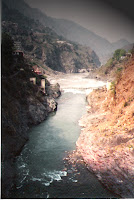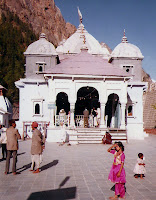Travel India Gangotri
The Birth Place of Ganga
Visiting Char Dham or the ‘four holy pilgrimages’ – Kedarnath, Badrinath, Gangotri and Yamunotri is every devout Hindu’s dream.
I stood on the bank of the river Bhagirathi bubbling and gurgling on its 1,500 miles long journey to the oceans.
All around were snow clad mountains.
I took off my clothes to take a dip in the holy river.
I am used to taking chilled shower after a steam or sauna in my gym.
When I entered the river, I shivered.
The water was far more chilly than I was accustomed to.
I shivered very badly.
But after a few minutes, my body adjusted to the coldness and I felt quite comfortable.
At that time, a strange thought crossed my mind.
Many of my foreign friends find it surprising that Indians worship the Ganga (or Ganges river).
Think from an Indian’s point of view.
The river waters the Gangetic plain – an area of 359,400 sq. km., roughly 10 per cent of India’s total landmass – providing the people water for drinking, cooking, washing and agriculture.
Every year, the rains wash down a lot of minerals from the mountains into the river which increases fertility and prosperity of the land.
During the ancient days, when there were few roads and far more dense forests, road journey was hazardous.
The river provided a safe means of transport – free from wild animals and other perils.
In the evening, I attended the temple prayers and aarti.
I had a strange feeling.
I felt the high mountains were looking down upon me – smiling and blessing me.
May be, all this was my imagination.
But many visitors have a similar feeling.
This is what makes the journey to such places so fascinating.
Gomukh
The Ganges River originates amongst the melting snows of a glacier – called Gomukh or Gangotri glacier – in the Himalayas. It is difficult to identify and pin point any particular spot.
But the river’s origin is taken as Gomukh (meaning cow’s mouth) – 18 kms trek from Gangotri.Here, the river comes out of a cave which does look like an open mouth.
Since the last Ice Age, the glacier has been melting and receding due to global warming.
But the rate of melting has doubled since the1970s.
In 1866, the British traveler Samuel Burn travelled up t o Gangotri.
He wanted to visit Gomukh.
But the local people did not allow him to go.
According to Burn, they believed that Gangotri was the holiest place and human interference in Gomukh was non-religious.
Today’s foreign tourists are lucky.
They can travel right up to Gomukh.
Bhagirathi
The river originates as Bhagirathi.
At Devprayag (prayag means a place where two or more rivers meet), another river, the Alaknanda, meets the Bhagirathi.
The two rivers mingle with each other – the name changes to Ganga (or Ganges) and travel onwards.
Gangotri
Gangotri is a small town nestling amongst the Himalayas at a height of 3,042 metres above sea level.
The Goddess Ganga is believed to have descended to the earth at this spot.
The Ganga temple was built on the bank of the Ganga river by a Gurkha General Amar Singh Thapa in the late 18th or early 19th century. 
During the winter months, the place becomes inaccessible.
The temple is closed down on Diwali day (November) every year and reopens in May.
During this time, the idol of Goddess Ganga is shifted to Mukhba village, near Harsil.
Mythology
How Ganga came down to earth
According to legend, after slaying the demons on earth, King Sagar decided to perform the Ashwa Megh Yagya to proclam his supremacy to the world.
A horse would be taken around the earth accompanied by the King’s 60,000 sons from Queen Sumati and one son Asmanjas from the second queen Kesani.
Indra, the supreme ruler of the gods, was afraid that if the Yagya was successful, he might lose his throne.
So he wanted to interfere with the Yagya.
He stole the horse and tied it to the ashram of sage Kapil Muni, who was then in deep meditation.
When King Sagar’s sons could not find the horse, they searched everywhere.
Finally, they found it tied near the meditating Kapil Muni.
The sixty thousand and one angry sons of King Sagar stormed the ashram of Kapil Muni disrupting his meditation as Indra had planned.
Kapil Muni was very angry.
He opened his eyes and turned all the sons into ashes.
The only way to bring them back to life was to bring down Goddess Ganga from the Heavens and wash the ashes with the holy water.
Bhagirath, grand son of King Sagar, meditated for a long time to persuade Ganga to come down to the earth.
But the coming down of Ganga would have been too torrential and would have caused colossal damage.
Finally, Lord Shiva agreed to receive Ganga in his large tresses to break her fall.
Ganga descended down to the earth, washed the ashes and all the sons came back to life.
The Bhagirathi ‘Shila’ located near the temple of Ganga marks the spot where Ganga descended on earth from heaven.
Recommendation
Gangotri, the source of the river Ganges and seat of the Goddess Ganga, is one of the four Char Dhams (Four Dhams).
Whether or not you believe in religion or mythology, the Four Dhams are exquisite places.
Visit them for their beauty.
At least for some time, you will forget all your worries and be one with nature.
Gangotri can be reached in a day by road from Rishikesh, Haridwar or Dehradun.
The journey is enchanting.
There are several good places where you can stay.
Grateful thanks:
The photo ‘Beautiful Mountains and Rivers’ has been taken by Amir Jacobi.






I want to say – thank you for this!
I bookmarked this site. Thank you for good job!
It is the coolest site,keep so!
viagra
Excellent site. It was pleasant to me.
Incredible site!
Excellent site. It was pleasant to me.
I want to say – thank you for this!
xanax